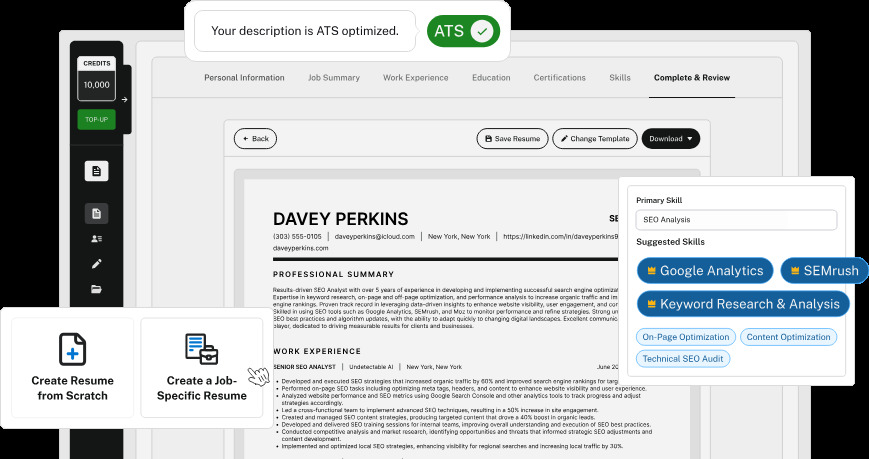Modern workplaces have changed significantly since the Covid-19 pandemic as the remote and hybrid models became more popular.
After the pandemic, more companies and employees are proving that the hybrid and remote models has come to stay.
However, this has sparked global conversations on hybrid vs remote work in corporate organizations.
This article offers a glimpse into both work models and the benefits you get compared to traditional offices.
You will also learn tips on what to look out for when applying for either remote or hybrid roles.
What Is Hybrid Work?
Hybrid work is a dynamic work arrangement where employees partly work from home or any other space outside the regular office space.
In a study by Accenture, 58% of people working remotely reported stronger work relationships and better mental health than those working full-time onsite.
In a hybrid work setting, employees can enjoy the benefits of working remotely while also getting the networking opportunities and in-person collaboration that working online offers.


Never Worry About AI Detecting Your Texts Again. Undetectable AI Can Help You:
- Make your AI assisted writing appear human-like.
- Bypass all major AI detection tools with just one click.
- Use AI safely and confidently in school and work.
Common Hybrid Work Schedules (Fixed, Flexible, Remote-First)
In our conversation on hybrid vs. remote work, we will expand with examples of different hybrid work schedules that many corporate organizations use based on their business models and workflow operations.
- Remote-First: Under this work schedule, employees are not required to come to the office. The staff operates a primarily remote workplace, and some organizations don’t bother to rent physical offices.
- Alternate Weeks: With this approach, an organization may require employees to be at the office one week and the following week off-site. It is used by several companies to balance in-person collaboration and more relaxed, remote work.
- Three-Day Onsite, Two Days Off: This is one of the most widely used schedules in a regular remote vs hybrid work calendar. The percentage of hybrid workers has reached 48% from 30% before the pandemic. Some workers work onsite from Mondays – Wednesdays but remotely on Thursdays and Fridays. While some work remotely on Tuesdays and Thursdays instead.
- Optional Onsite: Businesses under this model have a remote-first workplace but allow their employees to work onsite whenever it suits them. Some individuals who prefer to work at the office can go there whenever they want. It offers employees much flexibility and allows them to choose where and when to work.
- Flexible Hybrid: Employees choose when to work onsite and off-site in a flexible hybrid schedule. It offers a better work-life balance than other workplace schedules.
- Shift Schedule: This hybrid workplace setting is typically used in hospitals, customer service, and technical support roles. Workers have specific days of the week where they’re “on shift,” either throughout the night or the day.
Benefits Of Hybrid Work For Employees & Companies
Hybrid work schedules offer many modern businesses flexibility in their workflow operations.
Here are the top benefits of hybrid work:
- Get More Talent: In the hybrid vs. remote work debate, many companies use the hybrid work schedule to access a wider talent pool. Allowing their staff to work remotely means that companies can have employees outside the office location. It also helps attract skilled talents who prefer flexibility in their work.
- Saves Costs: This is an advantage for both the employees and companies. The company can save on power bills, travel benefits, and general office utilities. Employees can also save money on transport costs and general movement to the office.
- More Autonomy: A hybrid workplace offers employee work-life balance and more control in navigating their work schedules and requirements.
- Higher Productivity: Research has shown that workplaces with hybrid arrangements typically have higher productivity.
What Is Remote Work?
Remote work is the virtual work arrangement where employees work anywhere apart from the regular office workspace.
Usually, employees work from home or sometimes from coworking spaces to connect to the virtual workplace.
Under this arrangement, employees can still have meetings and team collaborations; the only difference is that it’s virtual.
Fully Remote Work vs. Work-from-Anywhere Models
We must examine the two main remote work styles to understand remote work vs hybrid work styles.
Under a fully remote style, employees work from home, in coworking facilities, or anywhere else in a set location. They work in the same geographical zone where the company operates.
For instance, a company based in the US may require its employees to also live in the US. This is usually a way to maintain control over the business operations and manage staff.
On the other hand, work-from-anywhere models allow employees to work from anywhere in the world.
You don’t need to factor in geographical location when applying for WFA roles because you can attend to your duties from anywhere.
This workplace model is fully remote, requiring a lot of trust and dedication between the company and staff to be fully effective.
Benefits of Remote Work for Employees & Companies
The following are the benefits of remote work, which will encourage our discussion on hybrid work vs remote programs.
- Building Talent Loyalty: With remote workers, an organization can help prioritize work-life balance and build more loyalty with employees who enjoy the perks of remote work.
- Cost-Effective: Remote work is a cost-effective strategy for many startup businesses. The office can save on rent, light bills, and other utilities. This expense can go towards improving business operations.
- Increase Productivity: Organizations have found that hybrid and remote work leads to higher productivity rates in their operations. Work time efficiency improves because staff members minimize their social interaction efforts while paying complete attention to their job responsibilities during official hours.
- Access to Talent: The absence of geographical restrictions ensures businesses can cast their net wide for candidates who do not need to reside close to their physical establishment. These companies achieve better competitive advantages because they can utilize talent from everywhere around the world.
- Diverse and Sustainable Work Environment: Remote work fosters an inclusive work environment with employees from different backgrounds and stories. Remote work supports an environmentally friendly lifestyle because it enables reduced carbon emissions together with waste reduction.
Hybrid vs. Remote Work: Key Differences
Employees gain flexibility through hybrid vs remote work arrangements to structure their workplace.
Both systems function differently based on their operational characteristics.
The following table illustrates major dissimilarities between hybrid work arrangements and remote work setups.
| HYBRID | REMOTE |
| Involves physical office work hours. | Completely off-site |
| Opportunities for in-person collaboration and networking. | All team collaborations take place virtually |
| Employees can access office resources and utilities, including power and internet. | Requires a lot of digital tools and strong internet service for a smooth workflow. |
| It fosters team bonding and a company culture. | Fewer chances for team bonding exercises |
Pros & Cons of Hybrid vs. Remote Work
There are two sides to the coin when discussing hybrid work vs remote working hours.
In this section, we’ll look closely at the pros and cons of hybrid and remote work.
Pros
Below are the pros of hybrid vs remote work:
- Reduced Burnout: It helps relieve the stress of both employers and staff, increasing productivity. Working from home allows employees to put more energy into work because they do not need to commute to and from work each day.
- Enhance Employee Retention: Hybrid workplaces now provide the flexible work environment which employees greatly sought since the COVID-19 outbreak. The approach delivers several work styles which enhance employee appreciation and slow down employee turnover.
- Less Time Off Request: Studies show that remote work employees typically request less time off than physical office workers. It allows them time to keep up with their personal engagements and maintain their work commitments when they must be physically at work.
Cons
Here are the cons of hybrid vs remote work:
- Limited Access to Leadership: In many hybrid workplaces, most employees complain of communication gaps and slow decision-making times. It is also hard to have spontaneous in-person meetings and networking opportunities.
- Requires Discipline and Strong Self Management: If you’re going to work in a remote setting, you need to learn how to manage your own time. It is important to maintain self-discipline together with regular attendance and promptly handle your assignments in order to maintain a workflow pace.
- Expensive Digital Tools: Remote work requires dependable internet and essential digital equipment starting with a functioning laptop along with a mobile phone and iPad based on what type of work tasks you need to accomplish. Anyone who cannot create a suitable workspace both at home and elsewhere should reconsider remote work.
- Isolated Work Environment: Your remote work setup will produce few interaction opportunities with coworkers that ultimately lead to isolation from colleagues and disconnection within the team.
How to Choose Between Hybrid & Remote Work
Suppose you’re considering changing your workplace model. In that case, you need to understand precisely how hybrid vs remote work dynamics will fit into your life.
Here are some tips to consider when choosing between hybrid and remote work:
- Career Growth: A hybrid model gives employees more chances for in-person meetings with leadership. This can help to foster career growth and advancement.
- Flexibility: If maximum flexibility is what you need, then you can go with a remote work arrangement. However, if you don’t mind flexibility with an in-person presence.
- Office Location & Commuting: Hybrid work still involves a lot of commuting, which requires time and money. Meanwhile, with remote work, you have more personal time and can save on transportation costs. So, you must consider how hard it will be to get to the workplace if you choose a hybrid style.
- Work-Life & Performance: The work environment you select should be able to improve your performance. Different workers have distinct preferences regarding their workplace environment.- some need supervision with collaborative teams but others achieve better results when working independently.
The Future of Hybrid & Remote Work
The ongoing conversations around hybrid vs remote work have sparked conversations about the future of workplace environments.
Technology development will drive an increase in hybrid work models combined with remote work arrangements.
Research indicates that workers seek flexible working arrangements and they will change jobs to get access to hybrid or remote positions.
Remote work systems have been adopted by tech industries together with the finance and consulting sectors.
Healthcare remains among industries that maintain traditional office hour procedures despite the changes in other sectors.
The advancement of AI tools and Augmented Reality (AR) software introduces work solutions to improve remote workplace systems.
Many companies are already starting to adopt 3D environments and metaverse workplaces.
Additionally, the work-in, work-out management style is declining, and many companies now adopt the performance-based management style.
This means managers will evaluate an employee’s work performance based on his output and results rather than just measuring when the employee shows up.
How to Succeed in Hybrid or Remote Work
Unlike in regular workplaces, you can easily succeed and get promotions by networking with leadership and standing out in team collaborations.
However, it’s harder to stand out and be visible when working in a remote job environment. It also helps to understand the workplace structures in remote work vs hybrid work if you want to succeed in the job market.
When applying for remote or hybrid roles, the first thing to consider is ensuring your resume speaks for you.
Since there is less opportunity for in-person communication and interaction with your potential employer, you need your resume to make an impression for you.
Fortunately, with our AI Resume Builder, you can refine your resume to fit any job description. It helps you identify skill gaps and errors to improve your chances of landing that role.

Another way to improve your chances of getting a fantastic remote job is to reach out for as many opportunities as possible.
You need to apply to as many jobs as possible because the job market is tight, and your chances of getting a role increase with the more jobs you apply to.
Using the Undetectable AI Smart Applier, you can efficiently remove this hiccup and apply for more jobs.

No matter which model you prefer, don’t forget to explore our AI Detector and Humanizer in the widget below!
Final Thoughts: Which Work Model Is Right for You?
Ultimately, since the COVID-19 pandemic, there has been a shift in workplace culture, and many employees are demanding hybrid work models.
However, the debate of hybrid vs remote work all boils down to preference.
You need to factor in your personal life and work goals when deciding which model is right for you, depending on whether you want more flexibility or a chance to network and collaborate in teams.
